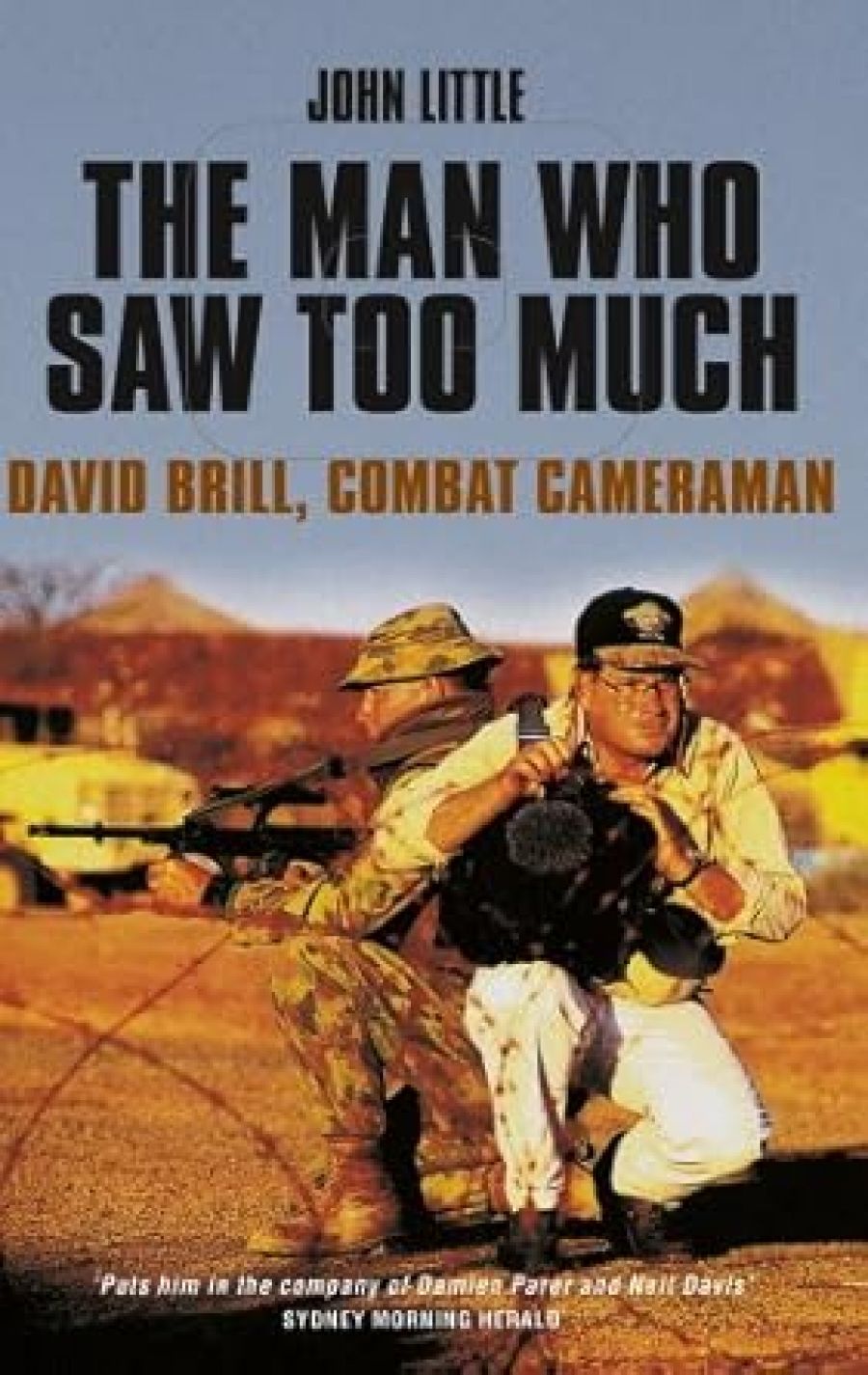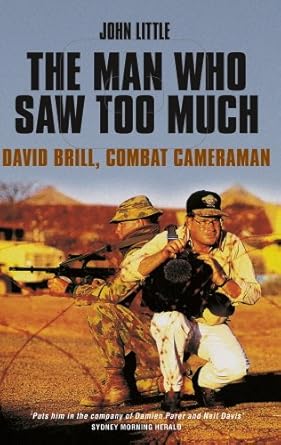
- Free Article: No
- Contents Category: Biography
- Review Article: Yes
- Article Title: An Ethical Newsman
- Online Only: No
- Custom Highlight Text:
Despite Jeff McMullen’s assertion in the foreword to The Man Who Saw Too Much that books like this are rare, this is in fact the latest in a long line of books about Australian war and foreign correspondents, by which I mean photographers, cameramen and women, and cinematographers (the term preferred by David Brill), as well as journalists. In recent times, books by, or about, the adventurous boys – Damien Parer and Neil Davis (both role models for Brill), Richard Hughes (whom Brill met in later life), Wilfred Burchett and Hugh Lunn – have, thankfully, been joined by autobiographies of women journalists such as Irris Makler.
- Book 1 Title: The Man Who Saw Too Much
- Book 1 Subtitle: David Brill, Combat Cameraman
- Book 1 Biblio: Hodder, $34.95 pb, 324 pp
- Book 1 Cover Small (400 x 600):

- Book 1 Cover (800 x 1200):

This book is about 59-year-old, Tasmanian-born David Brill, who has covered events from most of the world’s hot spots: Vietnam, Papua New Guinea, Africa, South and Central America, the Middle East and eastern Europe. (The island state, which Brill sometimes proudly purports to represent as an ambassador, has contributed much to the Australian news media, also producing Davis and even the Packers.)
The Man Who Saw Too Much is a rather curious book, as much autobiography as biography. Little is largely invisible – there is no note indicating that he was a senior producer on 60 Minutes and has written several other books – and it is the subject, rather than the author, who has been promoting the book. When I read that Little recorded some 150 hours of interview with Brill, I wondered why the loquacious cinematographer hadn’t written his own story; then I learned that Brill is dyslexic.
Adding to the autobiographical feel is the absence of any scholarly apparatus. There is little reference to the work of others (with the exception of studies of post-traumatic stress disorder), no bibliography and no index. If you want to read about Ray Martin, Don Burke or Monica Attard, you have to read the whole book – not such a bad thing, really. The occasional error intrudes: in 1961 the Australian had yet to be launched; there is no Hobart University; and 60 Minutes made its début in 1978, not 1998.
This nicely paced book has a certain filmic quality, with facets of Brill’s character revealed by friends and images that have haunted, at times obsessed, him flashed before the readers’ eyes. He appears as a complex figure, traumatised by a lonely childhood and a disapproving mother, and yet incapable of devoting himself to his own family as he did to his work; someone to whom bad manners, rather than wayward bullets, are repugnant; a man prepared to immerse himself in the world of commercial cinematography as well as public broadcasting because he just loves having the chance to use a camera. The composite image is of a man damaged by his childhood and the horrors he has seen, someone whose feelings of self-worth centre only on his work.
For all his flaws and failures – two unsuccessful marriages, alcoholism and excessive introspection – Brill emerges as an ethical newsman. On one of his earliest assignments, filming the 1967 bushfires that swept across Tasmania, Brill became aware of the dilemma that faces cameramen and journalists: whether to record tragedy as an impartial observer, or whether to get involved and try to help. At this stage in the biography, Little suggests that this disaster convinced Brill that he would always ask people for permission to film. It’s a nice idea, but I somehow suspect it hasn’t always been possible in practice: the speed of events, the involvement of children and the barriers of language have almost certainly made automatic requests of this kind impossible. And yet Brill is, it seems, unusual among his contemporaries for remaining empathetic rather than becoming cynical, and for his willingness – even compulsion – to engage journalists and producers in debates, often while on the road, about the ethics of what they are doing. In recent years, too, he has increasingly turned his experience and talents to the service of international aid agencies.
While The Man Who Saw Too Much moves between the spheres of advertising and corporate film-making, Australian and American commercial television networks, the ABC and SBS, it is the ABC that is the focus of much of this book. It’s not always a pretty picture, with the committee system preventing Brill from being appointed to posts to which he should have been appointed, and cost-cutting drives some-times forcing him to buy his own equipment and work without proper overseas allowances or even insurance. But before Richard Alston gets too excited, he should read to the end of the book, where Little points out that Australia’s public broadcasters now provide virtually the only outlet for the elegantly crafted extended stories involving considered analysis to which Brill has dedicated most of his life.
Just as Brill is committed to scrutinising world events, I can’t help but wish that someone would grasp the mettle and write a serious study of the Australian men and women who cover those events. Pat Burgess’s Warco was too celebratory; Prue Torney-Parlicki’s more recent Somewhere in Asia is important but confined to Asia. We’ve long been told that Australia has a distinguished tradition of war reporting and cinematography, something the fledgling C.E.W. Bean Foundation aims to acknowledge; and the International News Safety Institute has now been formed to work for the safety of news workers. Surely it is time for the life-writing of Australia’s foreign and war correspondents that has been flooding bookshops for decades to feed into a collective study of the correspondent’s role in disseminating information about the world beyond our shores, and comparing the experiences of war correspondents with those of other returned service men and women. The ‘colourful’ life stories of news workers such as David Brill are part of a much bigger story.


Comments powered by CComment